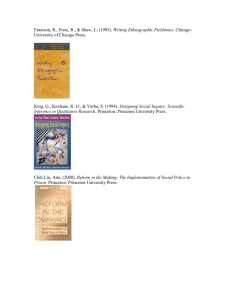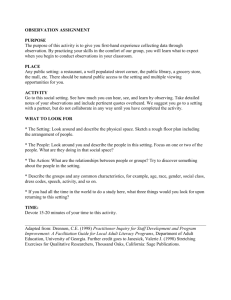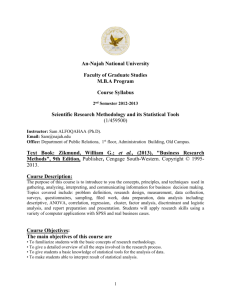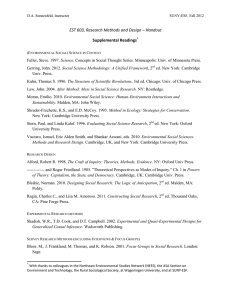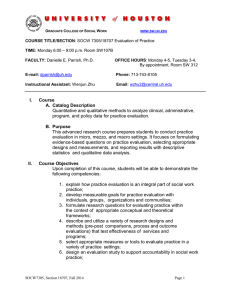34:833:530 Research Methods and Design
advertisement
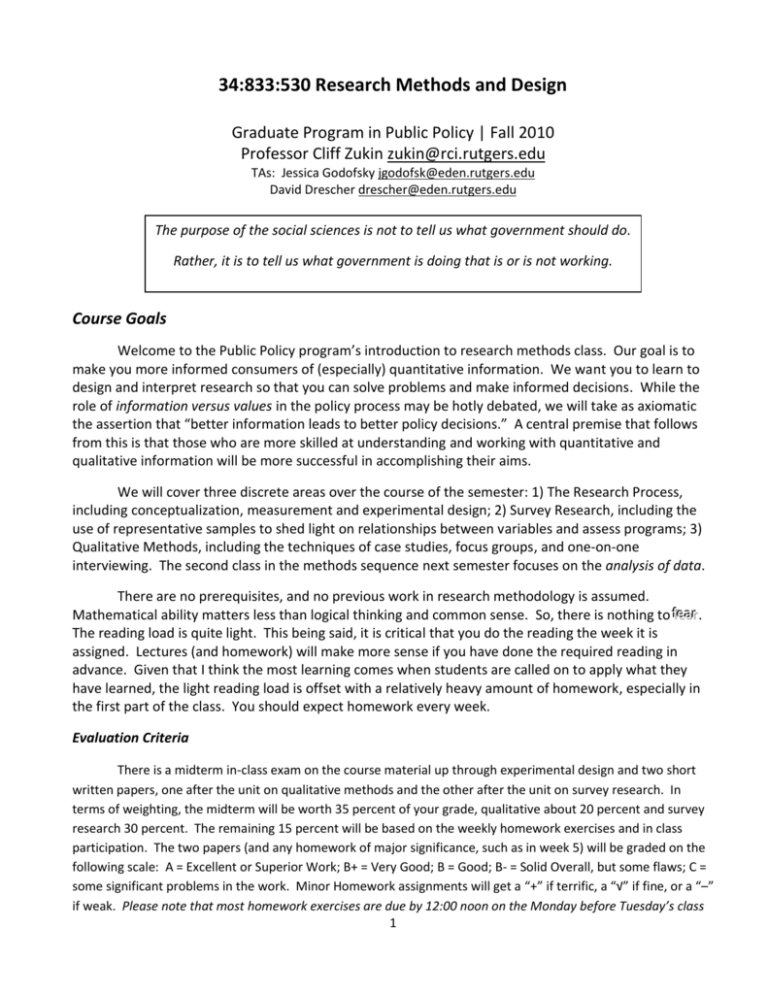
34:833:530 Research Methods and Design Graduate Program in Public Policy | Fall 2010 Professor Cliff Zukin zukin@rci.rutgers.edu TAs: Jessica Godofsky jgodofsk@eden.rutgers.edu David Drescher drescher@eden.rutgers.edu The purpose of the social sciences is not to tell us what government should do. Rather, it is to tell us what government is doing that is or is not working. Course Goals Welcome to the Public Policy program’s introduction to research methods class. Our goal is to make you more informed consumers of (especially) quantitative information. We want you to learn to design and interpret research so that you can solve problems and make informed decisions. While the role of information versus values in the policy process may be hotly debated, we will take as axiomatic the assertion that “better information leads to better policy decisions.” A central premise that follows from this is that those who are more skilled at understanding and working with quantitative and qualitative information will be more successful in accomplishing their aims. We will cover three discrete areas over the course of the semester: 1) The Research Process, including conceptualization, measurement and experimental design; 2) Survey Research, including the use of representative samples to shed light on relationships between variables and assess programs; 3) Qualitative Methods, including the techniques of case studies, focus groups, and one-on-one interviewing. The second class in the methods sequence next semester focuses on the analysis of data. There are no prerequisites, and no previous work in research methodology is assumed. Mathematical ability matters less than logical thinking and common sense. So, there is nothing to ffeeaarr. The reading load is quite light. This being said, it is critical that you do the reading the week it is assigned. Lectures (and homework) will make more sense if you have done the required reading in advance. Given that I think the most learning comes when students are called on to apply what they have learned, the light reading load is offset with a relatively heavy amount of homework, especially in the first part of the class. You should expect homework every week. Evaluation Criteria There is a midterm in-class exam on the course material up through experimental design and two short written papers, one after the unit on qualitative methods and the other after the unit on survey research. In terms of weighting, the midterm will be worth 35 percent of your grade, qualitative about 20 percent and survey research 30 percent. The remaining 15 percent will be based on the weekly homework exercises and in class participation. The two papers (and any homework of major significance, such as in week 5) will be graded on the following scale: A = Excellent or Superior Work; B+ = Very Good; B = Good; B- = Solid Overall, but some flaws; C = some significant problems in the work. Minor Homework assignments will get a “+” if terrific, a “√” if fine, or a “–” if weak. Please note that most homework exercises are due by 12:00 noon on the Monday before Tuesday’s class 1 so that they can be useful in the next day’s class. Please submit homework via the Assignment Tool in Sakai as an attachment and bring a hard copy to class. Late homework is not accepted. Late papers are downgraded. Readings There is one required textbook, Research Methods in Practice: Strategies for Description and Causation by Dahlia Remler and Gregg Van Ryan, Sage Publications, 2011. This carries the load during the first section of the class. We are using a mixture of readings to fill in the blanks for focus groups and survey research. All of these will be available as PDF documents on the class Sakai site. Contact Information My main office is at the Heldrich Center for Workforce Development (2nd floor, room 205). The entrance is at the corner of Livingston and New, different from the hotel entrance. Formal office hours are on Mondays from 1-2 and Wednesday from 10-12. I am happy to schedule appointments with you whenever I am in; the single best way to reach me is through email at zukin@rci.rutgers.edu. My phone number is 732.932.4100 x6205. We will send out an announcement when Jessica and David are available. Course Schedule of Topics and Readings Week Date 1 9/7 Topic Introduction PART 1 2 9/14 RESEARCH DESIGN The Scientific Method, Vocabulary, The role of Applied Social Research Read R&V Chapters 1-2 and pp 498-501 Homework 1: Write a research Problem Statement 3 9/21 Conceptualization and Measurement Read R&V Chapter 4 and pp 242-247; Guide to the Index of Civic Engagement Reading on School Rankings Homework 2: Pick a statistic and deconstruct it 4 9/28 Research Design 1/Causation Read R & V Chapter 10 and pp 395-410, 427-438 Homework 3: Find an example of research in the popular media 5 10/5 Research Design 2 Read R&V pp 355-372, 411-422, 439-454 Homework 4: Critique a research study 6 10/12 Research Design 3 Class Presentations 2 Homework 5: Prepare a Research Design 7 10/19 Midterm No Homework. You will be given a supplemental schedule of homework for Part 2 and 3 Part 2: Qualitative Research 8 10/26 Introduction to Qualitative Research: Case Studies and Interviewing Read R&V pp 55-66, 80-85; Rubin & Rubin Chapters 6-7; Lapan Chapter 9 Homework 9 11/2 Focus Groups 1: Overview & Design Read R&V pp 67-71; Krueger Chapters 1-2; Stewart Chapter 4 Homework 10 11/9 Focus Groups 2: Conduct & Analysis Read R&V pp 75-80; Stewart Chapter 6; Edmunds Chapter 5 and Appendix C Focus Group Paper Given; Due 11/16 Part 3 Survey Research 11 11/16 Survey Research: Overview and Sampling Read R&V Chapter 5 and pp 250-255, 195-205; Dillman Chapter 3 Homework 12 11/23 Survey Modes, Coverage, Election Polls, Field Work Read R&V pp 217-224; Fowler Chapter 8 Czaja & Blair Chapter 3; Zukin Primer Homework 13 11/30 Questionnaire Design, Wording and Placement Read R&V pp 224-239; Rea Chapter 2, 3; Colton Chapter 8 Homework 14 12/7 Ethics, Graphics, Catch up and Wrap Up Read TBD + R & V pp 21-23, 85-87; AAPOR Code & Best Practices; Tufte Survey Research paper given; Due 12/14 3 833:530:01 Research Methods for Public Policy Bibliography of Readings Colton, David and Covert, Robert W. 2007. Designing and Constructing Instruments for Social Research and Evaluation. San Francisco, CA: Jossey-Bass, Inc. Czaja, Ronald and Blair, Johnny. 2005. Designing Surveys: A Guide to Decisions and Procedures. Second Edition. Thousand Oaks, CA: Pine Forge Press. David W. Stewart, Prem N. Shamdasani and Dennis W. Rook. 2007. Focus Groups: Theory and Practice. Second Edition. Applied Social Research Methods Series, Volume 20. Thousand Oaks, CA: Sage Publications, Inc. Don A. Dillman, Jolene D. Smyth and Leah Melani Christian. 2009. Internet, Mail and MixedMode Surveys: The Tailored Design Method. Third Edition. Hoboken, NJ: John Wiley & Sons, Inc. Edmunds, Holly. 1999. The Focus Group Research Handbook. Chicago, IL: NTC Business Books. Fowler, Jr. Floyd J. 2009. Survey Research Methods. Fourth Edition. Thousand Oaks, CA: Sage Publications, Inc. Krueger, Richard A. and Casey, Mary Anne. 2009. Focus Groups: A Practical Guide for Applied Research. Fourth Edition. Thousand Oaks, CA: Sage Publications, Inc. Lapan, Stephen D. and Armfield, Shadow W.J. “Case Study Research.” Pp. 165-180 in Research Essentials: An Introduction to Designs and Practices. Stephen D. Lapan and Marylynn T. Quartaroli, eds. 2009. San Francisco, CA: Jossey-Bass, Inc. Rea, Louis M. and Parker, Richard A. 1997. Designing and Conducting Survey Research: A Comprehensive Guide. Second Edition. San Francisco, CA: Jossey-Bass, Inc. Remler, Dahlia and Van Ryan, Gregg. 2011. Research Methods in Practice: Strategies for Description and Causation. Thousand Oaks, CA: Sage Publications. Rubin, Herbert J. and Rubin, Irene S. 2005. Qualitative Interviewing: The Art of Hearing Data. Second Edition. Thousand Oaks, CA: Sage Publications. 4


